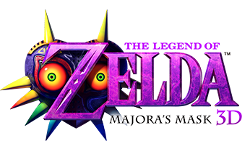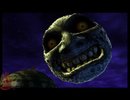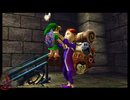|
|

|
PLATFORM
|
3DS
|
BATTLE SYSTEM
|

|
INTERACTION
|

|
ORIGINALITY
|

|
STORY
|

|
MUSIC & SOUND
|

|
VISUALS
|

|
CHALLENGE
|
Moderate
|
LENGTH
|
20-40 Hours
|
|
OVERALL

|
+ Beautifully updated graphics and UI
+ Rebalanced temples and item distribution
+ New camera system and worthwhile 3D
- Drawbacks in using the Circle Pad
- Some noticeably untouched character models
|
Click here for scoring definitions
|
|
|
After fifteen years the most polarizing installment in the Zelda timeline has finally been given a second chance to win gamers over, and I couldn't be more pleased. An action-adventure game both similar and somewhat dissimilar to its much lauded predecessor, The Legend of Zelda: Majora's Mask 3D is unlike anything you've ever played. Well, unless you've played the original release. Still, the improvements and alterations in this handheld iteration are enough that fans of the N64 title will likely want to reinvest their time and money, while those who might not have previously enjoyed the game will have an easier time getting into the experience.
Set in Termina, a vaguely familiar parallel of Hyrule, Majora's Mask 3D features a delightfully obtuse and subtext-heavy story in which Link's primary adventure is only one of many puzzle pieces. This new land, split into four areas (not including Clock Town) by four magical giants, has a story all its own that is more detailed and atmosphere-heavy than any other entry in The Legend of Zelda franchise. Roughly seventy percent of Majora's Mask's tale is delivered through side quests and easily ignored secondary objectives — something this game has in spades.
Taking place a few months after Ganon's defeat in Ocarina of Time, Young Link is in search of a departed friend with his horse Epona. Ambushed by a masked Skull Kid and his two fairy friends in the heart of the Lost Woods, Link is mugged and goaded into pursuing the assailant. The chase ends with a trippy, acid-inspired nightmare that Link wakes from only to find that he has transformed into a lowly Deku Shrub. It is soon revealed that the meddlesome Skull Kid has become possessed by the overwhelming power of an ancient relic known as Majora's Mask. With this sinister object, Skull Kid has initiated an impending apocalypse by forcing the moon to collide with the world in approximately three days. In order to stop the moon's decent and save the people of Termina, Link must regain his former form, clear the land's four temples of Skull Kid's disciples, awake the four magical giants in each region, and return to Clock Town to put an end to Skull Kid's reign of terror.
Normal conditions would prove this quest impossible, as each in-game "day" only translates to roughly eighteen minutes of gameplay time. Link, however, still holds an ocarina capable of time manipulation. Through the slowing, speeding, and reversing of time, Link will likely see Termina's eleventh hour dozens of times only to head back to the first day with all he has learned and earned before its destruction. As such, time is both an important gameplay and narrative device; one that will actively change the way objectives will be enacted and how the density of the game's atmosphere is felt.
 The moon is 87% more terrifying.
The moon is 87% more terrifying.
|
|
For the first time in The Legend of Zelda's franchise history, the perils of Link's failure and the results of his achievements are omnipresent. This adventure not only has visible stakes, but also actively tugs on the player's heartstrings in a way that will either make them feel empowered or disabled. Because the game's NPCs have their own scheduled daily habits and responses to main and secondary quests, they finally feel like developed individuals with somewhat realistic identities. Helping one NPC will often mean being unable to help another, as time is a precious resource. Sadly, this usually means abandoning NPCs that the player has come to love.
Side quests and secondary objectives are the heart of Majora's Mask 3D. As such, the experience is a collector's wet dream. The game features fifty-two heart pieces (the most in any Zelda title to date), seven bottles, over twenty NPC-driven side quests, tons of Bombers' Notebook secondary objectives, and dungeons chock-full of stray fairies. While a vast majority of these quests are optional, they both strengthen Link and add context to the events of Termina. For example, one quest thoroughly details Skull Kid's motivations for being vindictive towards the people of Termina while another quest may result in Link obtaining a mask that doubles his running speed. Simply put, completion goes hand-in-hand with enjoyment.
Completing quests of all shapes and sizes would be impossible without the right equipment. Curiously, Majora's Mask has two distinct varieties: traditional use-based items and wearable masks. Due to the time mechanic, each time the player hops back to the dawn of the first day Link loses all rupees and his stock of items. Secondary weapons like a bow and permanent items like a bottle will not be lost. Masks will never leave the inventory and have a variety of effects. Some can be used during combat, others are useful in the field, and some are only useful under certain contexts. As one of the key defining features of Majora's Mask 3D, transformation masks allow Link to turn into different races, enter a variety of environments, and perform unique moves in combat. This adds great depth and variety to the gameplay.
 More like Creepy Mask Salesman.
More like Creepy Mask Salesman.
|
|
Visually, Majora's Mask isn't terribly dissimilar to Ocarina of Time. A number of the same art assets and character models are used in both games. The 3D re-release of this game has seen some impressive environment, character model, and UI visual improvements. In fact, it may very well be the one of the nicest looking games on the 3DS. Sadly, it's also clear that some environments and characters were not touched up, and that pulls down the overall presentation. Still, the touch-ups do well to modernize the game and fans of the N64 release will notice and likely appreciate the changes. To that same point, Koji Kondo's masterful soundtrack has also received an audio touch up for 3DS speakers. It sounds just as good if not better than it did fifteen years ago.
The alterations made for a 3DS release were not just in the audio and visual departments. As with Ocarina of Time's re-release, there is now a map on the bottom screen as well as additional slots for items and/or masks, making puzzles and combat less encumbered with menus. With the New Nintendo 3DS or a Circle Pad Pro, the player will also have access to a new control style that allows for a free-camera — something that can make life a lot easier while battling bosses. Also, this may very well be the first game that deserves to be played from start to finish in 3D, as the feature works great and really makes the environments shine. Another big upgrade is the enhanced Bomber's Notebook, which now features an alarm, a detailed calendar of all three days with breakdowns for day and night, and quest tracking. Lastly, items and stray fairies have been moved to new locations to spice up the experience for veteran players and rebalance the experience of traversing through the temples for the better.
In spite of these additions, Majora's Mask 3D is not a perfect game. In as much as Link usually controls like butter with the Circle Pad, because the 3DS does not have an analogue stick swimming sections with Zora Link have become more aggravating to complete. Similarly, hovering with Deku Link isn't always a stress-free endeavor. The Song of Time also no longer saves the game while returning Link to the first day — a fact not well communicated. Instead, the player must rely on the previously useless owl statues for saving. The Inverted Song of Time still slows time, but not by as much and that can make completing some of the later environments a pain in the neck. These are all relatively small complaints overall though.
While it can't be said that the upgrades were drastic in The Legend of Zelda: Majora's Mask 3D, they were successful in making the experience more manageable for the player. Veterans will still find the Terminian challenge they know and love, but new players should no longer feel daunted by the game's expectations. The barriers to entry have finally been broken down on my favorite game in the Zelda timeline, and I'm thrilled that this overwhelmingly unique game has returned to subvert expectations and take its place as one of the Nintendo 3DS's must-have games.
Review Archives
|









